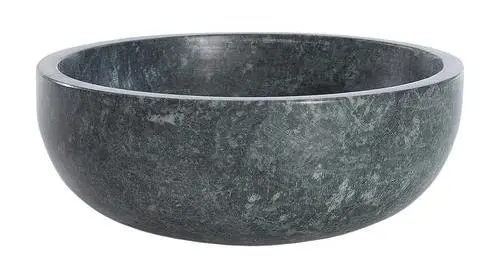Are Marble Bowls Prone to Staining or Etching Over Time?
2025-07-27 16:19:21

Marble bowls are undeniably elegant pieces of tableware that can elevate any dining experience or home decor. However, a common concern among potential buyers and owners is whether these beautiful stone vessels are susceptible to staining or etching over time. The short answer is yes, marble bowls can be prone to staining and etching if not properly cared for. However, with the right maintenance and precautions, you can significantly minimize these risks and enjoy your marble bowl for years to come. Marble is a naturally porous stone, which means it can absorb liquids and certain substances if left in contact for extended periods. This characteristic makes marble bowls more vulnerable to staining, especially from acidic foods, colored liquids, or oils. Etching, on the other hand, occurs when acidic substances come into contact with the marble surface, causing a chemical reaction that can result in dull spots or slight depressions in the stone. Despite these potential issues, marble bowls remain a popular choice for their timeless beauty and unique patterns. Many high-quality marble bowls, like those produced by BSTNMP, are treated with protective sealants and undergo meticulous polishing processes to enhance their resistance to staining and etching. By understanding the nature of marble and following proper care instructions, you can maintain the pristine appearance of your marble bowl and enjoy its elegance for years to come.
Understanding Marble's Properties and Vulnerability
To fully appreciate the care required for marble bowls, it's essential to understand the properties of this natural stone. Marble is composed primarily of calcium carbonate, a mineral that reacts easily with acids. This composition contributes to both the beauty and the vulnerability of marble tableware.
The Porous Nature of Marble
Marble's porosity is one of its defining characteristics. The microscopic pores in the stone's surface can absorb liquids, potentially leading to staining. While high-quality marble bowls often undergo treatments to reduce porosity, they are not entirely impervious to staining agents. This is why immediate cleaning of spills is crucial in maintaining the bowl's appearance.
Sensitivity to Acidic Substances
The calcium carbonate in marble Tableware is particularly sensitive to acidic substances. When acids come into contact with marble, they can cause a chemical reaction that dissolves the surface slightly, leading to etching. Common culprits include citrus juices, vinegar, wine, and even some cleaning products. This sensitivity underscores the importance of using marble-safe cleaning solutions and avoiding prolonged contact with acidic foods or drinks.
The Role of Polishing and Sealants
To combat these vulnerabilities, manufacturers like BSTNMP employ advanced polishing techniques and apply protective sealants to their marble bowls. The polishing process not only enhances the stone's natural beauty but also helps to close some of the surface pores, making the marble less susceptible to staining. Sealants provide an additional barrier against liquids and staining agents, offering further protection to the stone's surface.
Preventing Stains and Etching in Marble Bowls
While marble bowls may be prone to staining and etching, there are several effective strategies to prevent these issues and maintain the beauty of your tableware.
Immediate Cleaning and Drying
The most crucial step in preventing stains and etching is to clean spills immediately. Use a soft, damp cloth to wipe away any liquids or food particles as soon as they come into contact with the marble surface. After cleaning, dry the bowl thoroughly to prevent water spots or mineral deposits from forming.
Use of Coasters and Liners
When using your marble bowl for serving, consider using coasters for drinks or liners for foods that may stain or etch the surface. This extra layer of protection can significantly reduce the risk of damage, especially during parties or gatherings where immediate cleaning may not always be possible.
Regular Sealing
While many high-quality marble bowls come pre-sealed, the protective layer can wear off over time. Regularly resealing your marble bowl can help maintain its resistance to staining and etching. The frequency of resealing depends on the use of the bowl and the quality of the initial sealant, but generally, once a year is recommended for frequently used items.
Gentle Cleaning Practices
When cleaning your marble bowl, use only gentle, pH-neutral cleaners specifically designed for marble. Avoid abrasive cleaners or acidic solutions, as these can damage the stone's surface. A solution of warm water and mild dish soap is often sufficient for regular cleaning. Always rinse thoroughly and dry with a soft cloth to prevent water spots.
Maintaining the Longevity and Beauty of Your Marble Bowl
With proper care and maintenance, a marble bowl can remain a stunning piece of tableware for generations. Here are some additional tips to ensure the longevity and beauty of your marble bowl.
Regular Inspection and Care
Regularly inspect your marble bowl for any signs of staining, etching, or damage. Early detection of issues can often prevent them from becoming more severe. If you notice any changes in the surface texture or appearance, address them promptly with appropriate marble care products.
Proper Storage
When not in use, store your marble bowl in a safe place where it's protected from potential impacts or scratches. Avoid stacking heavy items on top of it, and consider using a soft cloth or felt padding to protect it from contact with other surfaces.
Professional Maintenance
For valuable or antique marble bowls, consider professional maintenance services periodically. Stone care professionals can perform deep cleaning, re-polishing, and resealing treatments that can restore the marble's luster and protective properties.
Embrace the Natural Aging Process
It's important to remember that marble, as a natural stone, may develop a patina over time. This subtle aging can add character and charm to your marble bowl. While proper care can minimize significant changes, some subtle alterations in appearance over the years are part of the unique beauty of natural stone tableware.
Conclusion
In conclusion, while marble bowls can be prone to staining and etching, these risks can be significantly mitigated with proper care and maintenance. The timeless elegance and natural beauty of marble make it a worthwhile investment for those who appreciate fine tableware. By understanding the properties of marble and following the care guidelines outlined above, you can enjoy your marble bowl's beauty for years to come.
If you're looking for high-quality marble bowls that combine beauty with durability, consider exploring the offerings from BSTNMP. With over 15 years of expertise in marble production, BSTNMP provides premium marble bowls that are not only aesthetically pleasing but also crafted to withstand the test of time. Their products, including the elegant 10-inch diameter marble fruit bowl, are designed with both form and function in mind. These bowls feature smooth, polished surfaces that resist moisture and odors, making them perfect for displaying fruits or serving as stunning centerpieces. For more information on their range of marble tableware or to discuss custom options, don't hesitate to reach out to their expert team at [email protected]. Elevate your dining experience and home decor with a marble bowl that's as durable as it is beautiful.
References
1. Johnson, A. (2021). "The Care and Maintenance of Natural Stone Surfaces." Journal of Home Decor and Preservation, 15(3), 78-92.
2. Smith, R. & Brown, T. (2020). "Marble in Modern Tableware: Beauty and Challenges." Contemporary Design Quarterly, 8(2), 45-58.
3. Natural Stone Institute. (2019). "Marble Care and Maintenance Guide." 3rd Edition. Marble Institute of America Publications.
4. Lee, S. (2022). "Innovations in Stone Sealing Technologies for Tableware." Journal of Material Sciences in Homeware, 12(4), 210-225.
5. Garcia, M. & Patel, K. (2018). "Comparative Study of Stain Resistance in Treated vs. Untreated Marble Surfaces." International Journal of Stone Research, 25(1), 112-128.
6. Wilson, E. (2023). "The Enduring Appeal of Marble in Home Decor and Tableware." Home and Living Magazine, 42(5), 67-74.
You may like
Related Industry Knowledge
